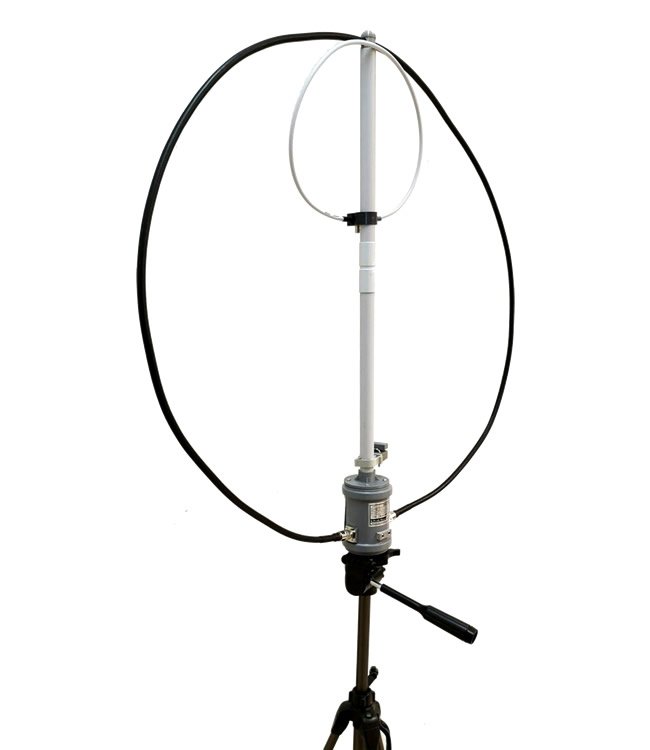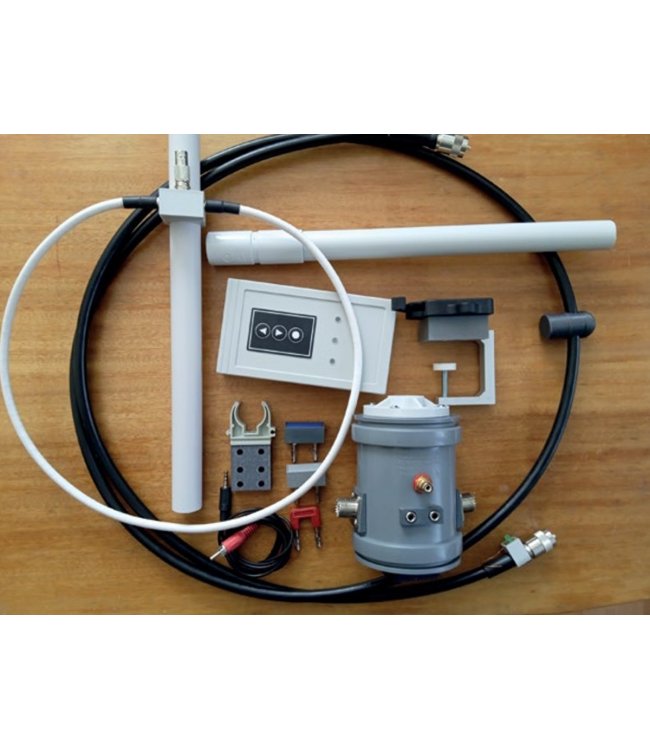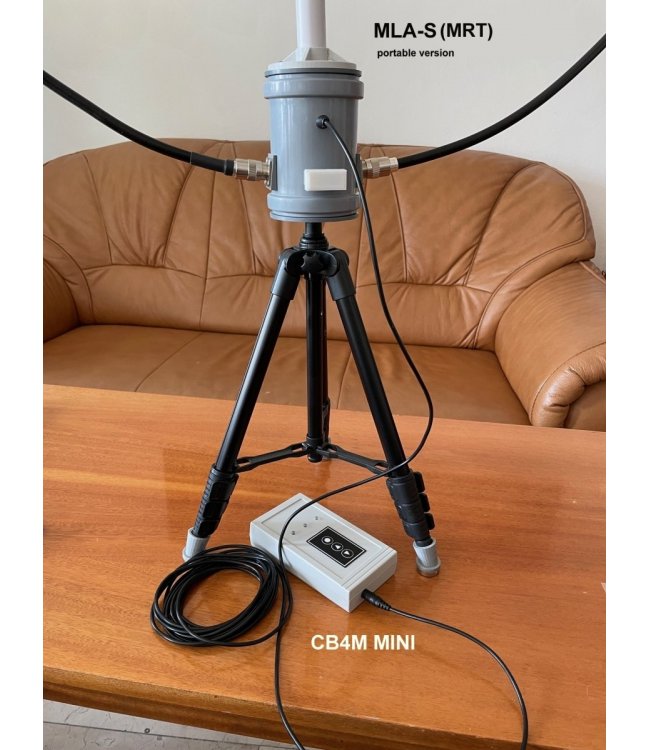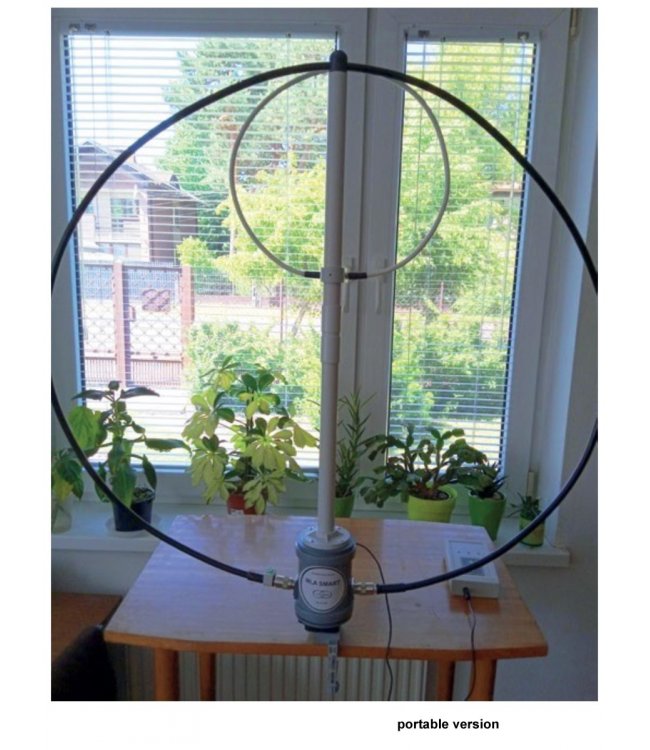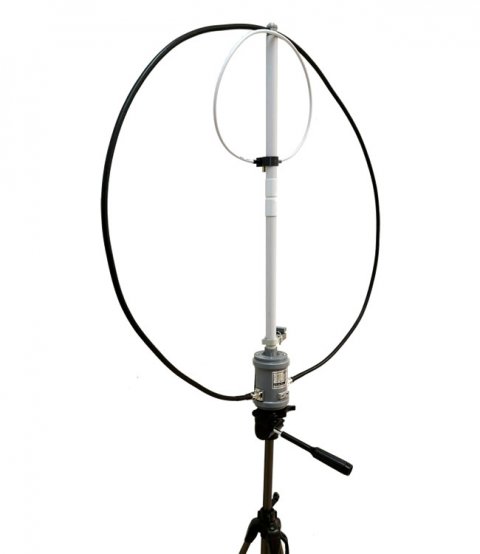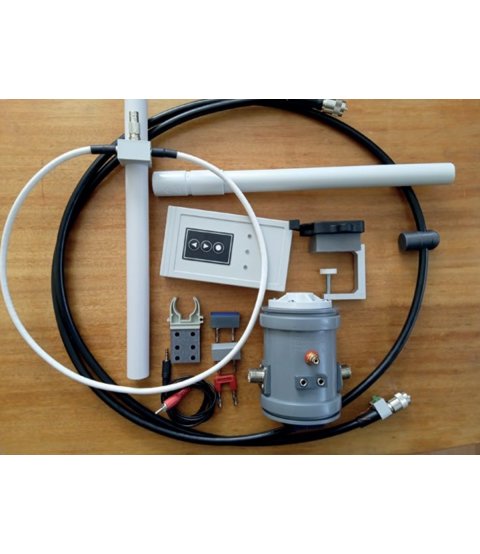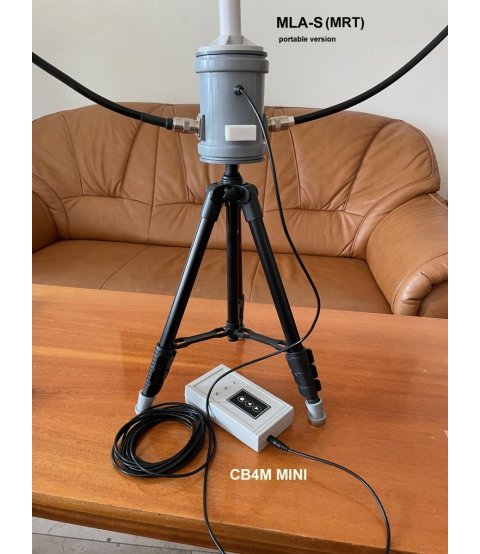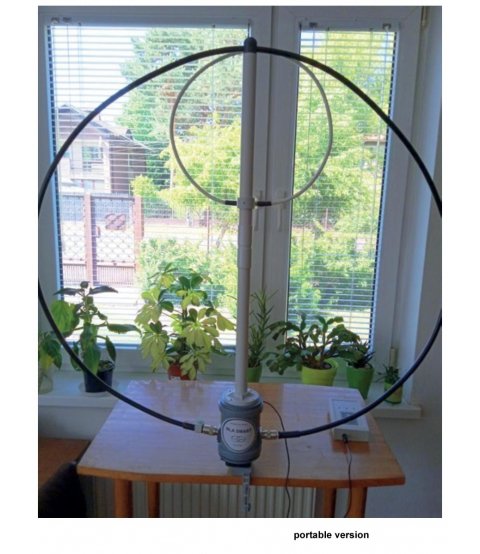MLA-S (MRT) portable
- Home
- Magnetic loop antennas
- MLA-S (MRT) portable
MLA-S (MRT) portable
The MLA-S (MRT) is operable on amateur radio bands from 80m to10m with a maximum power rating of 50W.
Price
Availability:
in stock
Description
The MLA-S (Multiband Remote Tuning) is a newer variant of the well-known MLA-S (MMT) model (Multiband Manual Tuning), which with regard to the usability from 80m to 10m with 40W output power belongs to one of the most popular commercially produced magnetic loop antennas in this price category. The MLA-S (MRT) elevates the utility of the MLA-S (MMT) by being designed for remote tuning (RT), and by increasing the power sizing up to 50W. The method of installation is by means of a three-legged tripod with 1/4" universal fitting. Tripod is not included.
Bands and power
The MLA-S (MRT) is operable on amateur radio bands from 80m to10m with a maximum power rating of 50W. When transmitting with this maximum usable power, it is not advisable to sit at the wake-up antenna less than 5m away. The antenna is not safe for operators with pacemakers! The switching of the band segments is done by two external JUMPers according to the table below.
Red - 80m and 60m
Blue - 40m and 30m
without jumper 30m to 10m
Tuning within the segments is provided by a DC motor, which is connected to the CB4M MINI driver box via an audio cable with 3.5mm JACK connectors. Because the variable capacitor used has stops (it only rotates 180 degrees), standard use of this type of capacitor tends to be more complicated and requires the use of limit switches and simpler electronics. The innovative MLA-S (MRT) solution significantly simplifies the use of a variable capacitor that only rotates 180 degrees, without these otherwise necessary complications. Remote tuning is provided by the CB4M MINI controller electronics. Unlike its use with the MLA-S (portable RT) antenna, the arrows on the CB4M MINI controller can be designated as FRQ UP and FRQ DWN. A more detailed description of the controller is below. The appearance of the MLA-S (MRT) and the CB4M MINI controller can be seen in Figures 1 and 2. The CB4M MINI controller is included in the package.
CB4M MINI
CB4M MINI is a CONTROL BOX for remote tuning of magnetic loop antennas. It extends the range of previously used CB4M, CB4M DUO, CB4M UNI controllers, which were created gradually with the continuing development and expansion of the type range of magnetic loop antennas produced by BTV and LOOPER SYSTEMS.
The CB4M MINI is the simplest of the range of drivers. Because it uses knowledge accumulated over several years, it performs the remote MLA tuning function very well even without the PWM control previously used. Unlike the CB4M, the CB4M DUO has an integrated internal 9V replaceable battery to power the controller electronics and to operate the DC motor that turns the magnetic loop antenna capacitor. The battery power supply significantly reduces interference (background noise) caused by poor quality mains adapters.
Unlike the CB4M and CB4M DUO, the CB4M MINI is not equipped with a DC turnout (bias -T). Therefore, an additional cable is required to control/tuning the MLA-S (MRT). A standard JACK/JACK (male) audio cable is used to connect the MLA-S (MRT) to the CB4M MINI, supplemented with a 5m or even 10m extension cable as required. Both the MLA-S (MRT) and the CB4M MINI are equipped with a stereo (female) 3.5mm JACK connector. The 3.5m cable and 9V battery are included.
CB4M MINI control - MLA-S (MRT) tuning
For remote tuning of the MLA-S (MRT), the CB4M MINI is equipped with three buttons on the top panel of the cabinet. Two buttons (triangles) provide FRQ UP/FRQ DWN functions, the third button (circle) switches the tuning speed - coarse/soft. This function of the CB4M MINI is solved by changing the voltage for the DC motor. In the fast tuning mode, the rotation speed of the DC motor can be factory set using the internal R-trimmer. In fine tuning mode the voltage/speed is fix. The two outermost LEDs on the top panel indicate FRQ UP/FRQ DWN tuning, the middle LED indicates the tuning speed in color. Green - slow mode, orange - fast mode. The CB4M MINI controller is shown in Figure 1. Figure 2 is a detail of the MLA-S (MRT).
TEST of HF magnetic loop antenna
Radio amateurs discover the usefulness of magnetic loop antennas
MLA-S (MRT) antenna
The newest magnetic loop antenna from OK2ER - the MLA-S (MRT), is a remotely tuned MLA for the entire HF range from 80 m to 10 m - in a portable design (simplifying transport and packaging/price). The diameter of the main loop is 80 cm and the excitation loop 25 cm. The antenna includes a CB4M MINI remote control.
The test of the antenna was made by Andrzej SP9HZX
For more than 6 weeks I have been using the latest portable antenna from the workshop of Olda OK2ER with satisfaction. It is MLA-S (MRT) from April this year. Included in the package is a carefully written instruction manual. The antenna is lightweight, weighing only about 1,6 kg. The antenna loop itself is 80 cm in diameter.
When unfolded, it fits into a very nice and practical backpack that was included.
In my case, besides the antenna, two radios, 2 batteries and other accessories fit in the backpack.
It takes about 3 minutes to assemble the antenna. The MLA-S (MRT) antenna, like all the antennas from Olda - OK2ER, is very professionally made, both mechanically and electrically.
I have used the antenna with two transceivers: a TenTec Scout555 with 50 W + 14 Ah battery or car battery, a Yaesu FT891 with 20 W + QRP-UPS solar source and solar panels or 50 W and 14 Ah battery. I always use a 1:1 balun, either on ferrite or air.
Tuning the MLA-S (MRT) is easy and fast. Quickly changing bands is seamless. The antenna works on all bands from 80 to 10 m. A red jumper is used when operating on the 80 m and 60 m bands and a blue jumper is used on the 40 m band. No jumpers are used on bands 30 m and above. Precise tuning of the antenna is quick and easy. On all HAM bands in the whole HF range the SWR is close to 1, the worst is 1.2. I usually tune the antenna using an LED indicator to roughly show the field strength, or using an external or built-in SWR meter. Both more accurately indicate the level of maximum excitation intensity. The readings from the reflectometer are virtually identical to the LED indicator.
When tuning this antenna, it is advisable to use a low power of 5-10 watts. Tuning is done using the CB4M Mini controller, which is powered by a replaceable 9V battery. The driver draws very little current, and even after several weeks of heavy battery use the driver still works. The CB4M Mini has two tuning buttons UP and DWN. The third button has two modes: slow tuning (green LED) and fast tuning (orange LED). Tuning the MLA with the CB4M Mini is easy, fast and accurate.
In my pad, the FCL (Faraday feedback loop) has the same shape on all bands. No need to move it at all, I think I'm very lucky, it's not quite usual. I've done quite a lot of measurements with a Stick230 analyzer, at 50 watts. I was most interested in the frequency response (an idea of the Q of the antenna and its efficiency). I got the following bandwidths: 80 m - 20 kHz, 60 m - 20 kHz, 40 m - 40 kHz, 30 m - 38 kHz, 20 m - 40 kHz, 17 m - 50 kHz, 15 m - 50 kHz,12 m - 50 kHz,10 m - 130 kHz. So it's not all bad. Although I am not involved in CB bands, I have practically verified the behaviour of this antenna in 11 m (CB) band. It is similar to 10 m band. Wide bandwidth and easy tuning.
I read somewhere that in the 80 m band you cannot operate SSB on the MLA because the bandwidth is too narrow. I have several MLAs and the bandwidth is quite sufficient for SSB operation even on 80 m band. I get very good reports and so far no one has complained about the signal quality.
During the holidays I used the MLA-S (MRT) for several weeks even in extreme weather conditions. Temperatures of 43C and high humidity, dry ground. Also on the boat at sea or on rocky coasts and sandy beaches. I made about 350 QSOs morning and evening during the holiday, both SSB and CW. There were even a few long distance QSOs on 10m on FM. I mostly used the higher bands and got a lot of very long QSOs, several thousand km each. A few on 40 and 60 m and even on 80 m for 2-3 thousand km. Power from 5 to 50W.
The MLA-S (MRT) antenna is designed to work with vertical polarization. Personally, I usually use a tripod, where the antenna is about 1.7 m above the ground. Sometimes I mount it on a special bracket on the roof of my car. On dirt roads you can (slowly) drive with the MLA on the roof of the car. The antenna is held in place by straps held by three magnets on the roof.
The MLA-S (MRT) antenna worked very nicely from the deck of the boat, the beach, and various patios and balconies from the 1st to the 8th floor. I also made several QSOs from inside the buildings. If the building is stone, brick or wood, the MLA works perfectly. In reinforced concrete buildings it is a bit of a problem, but with an antenna placed near a window, it is possible with more patience to make long distance contacts, not only CW but also SSB. I have had some interesting DX QSOs on 40, 30, 20 and 10 meters.
Conclusion. To the best of my knowledge, there is no other commercial magnetic loop antenna that operates over the entire HF range with 50 watts of power and remote control. The antenna works well on SSB, on CW and on FT8. Incidentally; even its price is very attractive considering its functionality.
Andy SP9HZX
Technical parameters
- Frequency range:3,5 to 28 MHz
- Input impedance:50 Ohm
- Typical Q:up to 250
- Maximum usable power:50 W
- Best achiavable SWR:1:1 max 1:1,2
- Input connector:BNC
- Dimensions:0,85 x 0,17 x 0,90 m
- Weight:1,6 kg
- Loop Diameter:850 mm
- Antenna tuning indicator:yes
